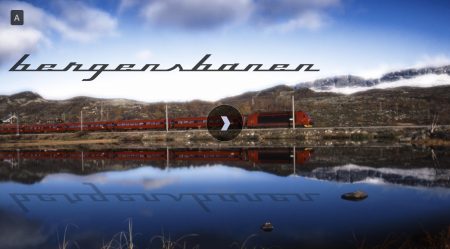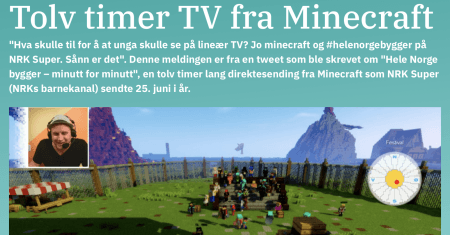The Norwegian public service broadcaster NRK just premiered the longest slow TV broadcast ever with Svalbard Minute by Minute documenting a nine-day Arctic expedition. Next week the Swedish public service broadcaster SVT will try to convince children that slow TV is also for them with two weeks of live broadcasting from 6.30am to 8pm from a Swedish farm.
By Eva Novrup Redvall, PI of the research project Reaching Young Audiences
Since the Norwegian public service broadcaster NRK started experimenting with slow TV with the broadcast of a 7-hour train ride across Southern Norway in 2009, the Scandinavian countries have seen a number of different examples of how to broadcast landscapes or events unfold in real time at their natural pace. 1.2 million Norwegians turned in for the ride with Bergensbanen in 2009. Two years later, 134 hours of live coverage from the ship MS Nordnorge’s voyage from Bergen to Kirkenes had 3.2 million Norwegians watching, giving the programme a market share of 36% and making NRK2 the most watched channel in Norway during the broadcast (NRK 2020).

Fig.1 : NRK’s Bergensbanen Minute by Minute successfully launched slow TV in Norway in 2009. Image from tv.nrk.no
In 2013, ‘slow TV’ was named “new word of the year” by the Language Council of Norway, and the international press also started taking an interest in this ‘marathon TV’ phenomenon with long duration minute-to-minute broadcasts. Researchers began writing about this new form of observational documentary and analyzing the narrativity in slow TV (e.g. Irving 2017) and about trends in new productions that have generally been marked by two main tendencies; Travel-based programmes focusing on a journey from one place to another in real time, or theme-based programmes documenting mundane activities such as 18 hours of salmon spawning or knitting, as in the 8-hour NRK production ‘National Knitting Night’ (Puijk 2017; 2019; and forthcoming 2020).
Svalbard Minute by Minute – but not live
With a track record of a little more than 10 years, slow TV seems to be moving strongly into Scandinavian public service broadcasting in the 2020s. On January 31st, NRK marked the 100th anniversary of the Svalbard Treaty by premiering Svalbard Minute by Minute, the longest slow TV broadcast ever. Over nine days, five hours and 59 minutes, the programme chronicled a nine-day Arctic expedition around the largest of the Svalbard islands Spitsbergen. The trip was filmed with 17 cameras in August 2019 since it would be too dark to film in Svalbard at this time of the year. The social media comments from people watching were continuously incorporated in the beautiful images of the wild Northern nature so that people could get a sense of belonging to a community of people watching.

Fig. 2: Svalbard Minute by Minute is NRK’s latest venture into slow TV and the longest slow TV broadcast ever. Image from tv.nrk.no
The first weekend had almost 1 million people tuning in on a daily basis which is more than the average viewership on NRK2 on a regular weekend. One of the viewers of the broadcast was my sister-in-law, who used some of the 13.319 minutes from Svalbard to explore these landscapes to find new inspiration for her paintings. Comments on social media had people argue that programmes like these are the main reason for buying big TVs, while many other comments illustrated how this sort of couch tourism has a wide appeal, both for people who have already visited the region or dream about going someday (Bergh 2020).
Four criteria for good slow TV
By now, slow TV is an established genre in Norwegian television, and NRK producers have been given numerous talks about how to make this kind of television at industry events or Ted Talks in the 2010s (e.g. Hellum 2014). According to an article celebrating the 10-year anniversary of slow TV at NRK, NRK had broadcast 23 slow TV programmes by 2019, adding up to almost 2 months of slow tv since the first programme in 2009 (Lindebø 2019).
Thomas Hellum, project leader for slow TV at NRK, has explained that NRK has four main criteria for slow TV (in Nordlund 2020, my translation and edit):
- There should be an unbroken timeline – nothing is edited out;
- Preferably live broadcast – you never know what might happen;
- It has to be broadcast on linear television – and preferably in primetime. Broadcast TV still gathers the largest number of viewers and highlights the sense of community;
- The content should be focused on something that many people can identify with, something with roots in (Norwegian) culture.
While this year’s Svalbard journey wasn’t broadcast live, the nine-day programme once again proved that there is an appetite for this kind of TV among Norwegian viewers. And while slow TV in its purest form might be a live transmission, there have been many other kinds of programming with slow TV elements, but no liveness, as discussed by Catherine Johnson when writing about how the four-part BBC series about the Pennine Way national trail in the UK captured the experience of walking on TV (Johnson 2015).
Moose migration as a living painting
While Danish television has yet to produce its first slow TV, the Swedish public service broadcaster SVT has successfully moved into the slow TV territory in the past few years. Last spring, SVT aired The Great Moose Migration (‘Den store älgvandringen’) that promised to be three weeks of following moose walking the path that they have walked for a thousand years to get to the rich summer pastures in the North of Sweden – Except there weren’t any moose caught by any of the 22 cameras for the first five days of airing, as told by SVT producers Johan Erhag and Stefan Edlund when they presented the programme at the Nordvision industry event Digital Narratives in Copenhagen in September.

Fig. 3: SVT’s The Great Moose Migration turned out to be popular with viewers and will have a second season in 2020.
At first they thought that this was a disaster, but it turned out that it almost became a sport to be the first person to spot a moose, and viewers still enjoyed watching the landscapes and appreciated what Erhag and Edlund described as ‘the moving painting in their living room’. In fact, the programme ended up being hailed as ‘one of the TV highlights of the spring’ (TT 2020) with more than 3,4 million starts and 4,7 million watched hours (Erhag and Edlund 2019). There was a dedicated facebook group for discussions and feedback, and SVT has announced a second season of documenting the moose migration for the spring of 2020.
Slow TV targeting children and young audiences
Maybe the success with the moose migration is what has inspired SVT to now also move into slow TV for children. On February 17, SVT Play and SVTs children’s channel SVT Barn will be transmitting live from a Swedish farm in Västerbotten every day from 6.30am in the morning to 8pm in the evening for two weeks (https://svtplay.se/garden-live). The programme, Gården: Live (‘The Farm: Live’), is set at a farm that not only has traditional Scandinavian animals, but also lamas and camels. The star of the programme seems to be the lama Aladdin, and apparently Swedish children will be able to interact with Aladdin and co. SVT promises that viewers can influence life at the farm through participating in various events on svtbarn.se and in the app SVT Barn.

Fig. 4: SVT’s Gården: Live is targeted at the audience of the children’s channel SVT Barn which targets younger children (3-6-year olds) as well as older children (7-11-year olds).
Until now there have been few attempts to target children and young audiences with slow TV. As analysed by Roel Puijk at the ECREA interim conference The Youthification of Television and Screen Culture last year, the NRK 2018-production Monsen Minute by Minute (with a 4-week hike across national parks) targeted teenagers with a mission statement to show a viewer like the 14-year old Peder ‘that nature is a playful, social and exciting place for him and those he cares for’ (Puijk 2019). The programme was built around five hours of walking with a summary in the evening as well as an entertainment programme where one of the hosts was known from the NRK hit series SKAM. However, the programme got low ratings, and NRK is still trying to figure out whether this type of television appeals to the younger audiences.
Slow meets co-creation
Some sort of interaction or co-creation as outlined with SVT’s Gården: Live might be an important ingredient. In 2016, NRK’s children’s channel NRK Super ventured into a 12-hour gaming version of slow TV with a programme where 750 builders collaborated on building a digital Norwegian national park in Minecraft (‘Hele Norge bygger – minutt for minutt’). The programme had prime minister Erna Solberg as one of the builders together with children in the target audience and artists performing live while the building was going on.

Fig. 5: In 2016, NRK experimented with slow TV for younger audiences by using Minecraft as the arena.
While virtual worlds might offer an interesting slow TV arena for the younger audiences, NRK hasn’t experimented with this kind of programming since then, and maybe live action animals in a farm fare better. It will be interesting to see whether Aladdin and his friends find an excited and engaged crowd. Erhag and Elund told that The Great Moose Migration was popular in Swedish classrooms because watching it made the students calm. If nothing else, watching animals live in a farm might have a similarly soothing effect – and the odds of spotting an animal in the first five days definitely seem remarkably better than in the 2019 moose expedition.
Eva Novrup Redvall is Associate Professor at the University of Copenhagen where she is head of the Section for Film Studies and Creative Media Industries and principal investigator of the RYA research project.
References
Bergh, Nicholas. 2020. ”NRK roses for nytt sakte-TV-program.” Aftenposten.no, 31 January 2020.
NRK. 2020. ‘Slow TV’. https://nrk.no/presse/slow-tv-1.12057032.
Hellum, Thomas. 2014. “The world’s most boring television … and why it’s hilariously addictive.” Talk at TEDxArendal, August 2014, https://ted.com/talks/thomas_hellum_the_world_s_most_boring_television_and_why_it_s_hilariously_addictive/transcript?language=en.
Irving, Dan. 2017. “Eighteen hours of salmon: On the narrativity of slow TV.” Frontiers of Narrative Studies 3:2, doi: 10.1515/fns-2017-0016
Johnson, Catherine. 2015. “All aboard slow TV: Capturing the experience of walking on TV.” CSTOnline, 15 May. https:///all-aboard-slow-tv-capturing-the-experience-of-walking-on-tv-by-catherine-johnson/
Nordlund, Thomas. 2020. ”NRK på Svalbard – ultimat slow-tv under nio dygn.” Nordvision.org, 31 January, https://nordvision.org/nyheter/nyhet/nrk-paa-svalbard-ultimat-slow-tv-under-nio-dygn/
NRK. 2020. “Slow TV.” nrk.no. https://nrk.no/presse/slow-tv-1.12057032
Puijk, Roel. 2017. “Minute for minute – ‘slow TV’ in Norwegian public service television.” Paper at the Nordmedia Conference in Tampere, Finland.
Puijk, Roel. 2019. “Youth as target audience for slow TV.” Paper presented on 25 October at the ECRA interim comference The Youthification of Television and Screen Culture in Groningen.
Puijk, Roel. Forthcoming 2020. Slow TV: An Analysis of minute-by-minute television in Norway. Bristol: Intellect Press.
Vedeler, Joakim. 2016. ”Tolv timer TV fra Minecraft.” Nordvision, org, 11 October, https://nordvision.org/nyheter/nyhet/tolv-timer-tv-fra-minecraft/
TT. 2019. ”Miljoner visninger för långsamma älgar.” Aftonbladet.se, 7 May. https://aftonbladet.se/nojesbladet/tv/a/GGwpjQ/miljoner-visningar-for-langsamma-algar






Goodness! How brilliant! That was a really fascinating read and it’s filled me with an enthusiasm which totally goes against the spirit of Slow TV… even now, I’m aware that I’m typing this *far* too fast!
Here in the UK, the uptake of Slow TV has been – as far as I’m aware – slow. Which seems entirely appropriate in some respects. The stand-outs in my mind were the three two-hour “All Aboard!” broadcasts from BBC Four, taking us on “The Canal Trip”, a trip out on “The Country Bus” and a delightfully festive snowy treat with “The Sleigh Ride”.
What I really found fascinating was the reasons for people interacting with these shows, maybe over and above the producers’ intentions. Your sister-in-law’s experience is a brilliant by-product which filled me with delight, and I love the absence of whatever the plural of moose is giving a new “raison d’etre” to “Den store älgvandringen”.
A really lovely read. Thank you. Much appreciated! 🙂
All the best
Andrew
Lovely to hear that this led to enthusiasm and fast typing!
I do think that slow TV is a fascinating phenomenon and I look forward to Roel Puijk’s forthcoming book on the topic. And to following Gården:Live and seeing how children engage with this initiative – or not …
It would also be fun if my sister-in-law end up producing some slow TV paintings, but I think that might take some time
All the best from Copenhagen,
Eva
And all the best to you too from a rather soggy England Eva – thanks for your kind response. 🙂
All the best
Andrew